Home »
MS Excel
Excel VBA Tutorial
By IncludeHelp Last updated : November 17, 2024
Table of Contents
What is (VBA) Visual Basic for Application?
VBA (Visual Basic for Applications) is a programming language developed by Microsoft. Since, it’s developed by Microsoft so it facilitates its users for automation and customisation in Microsoft Office applications such as Excel, Word, Access, and PowerPoint. It is a subset of the Visual Basic programming language designed to work with the Office suite's features. VBA follows Visual Basic programming language features. It enables users to build macros which includes set of Programming statements that execute operations and automate task
VBA enables users to create custom functions, change user interfaces, and control Office program workflows to meet unique requirements. For example, with Excel, VBA may automate data entry, formatting, and calculations, as well as sophisticated procedures like data integration from different sources. VBA is especially useful for people who lack extensive programming skills since it gives an easy way to increase productivity by exploiting the built-in tools of Office products.
How to Open VBA in Excel?
VBA is integrated with MS Excel; to open first of all open MS Excel and then press Alt + F11 or Fn + Alt + F11. It will look like this:
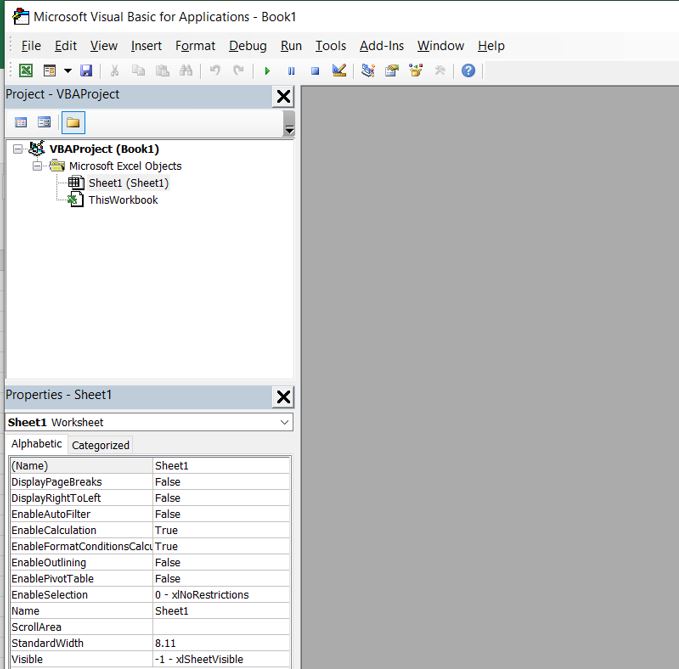
- Editor: The Visual Basic Editor (VBE) can be accessed from within Office programs (for example, by pressing Alt + F11 in Excel).
- Macros: Small scripts or programs written in VBA that perform tasks when triggered.
- Object-Oriented: VBA relies on manipulating objects, such as workbooks, worksheets, cells, documents, and slides.
How to Insert a Module in VBA?
-
Click on Insert Menu

-
Click on Module
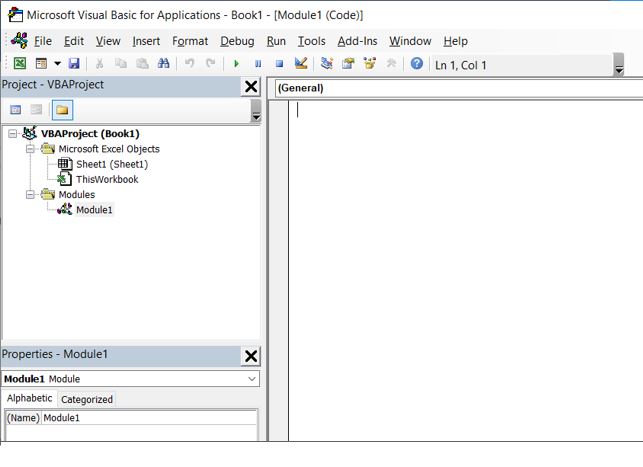
Module added, now you can start to Write VBA Code like:
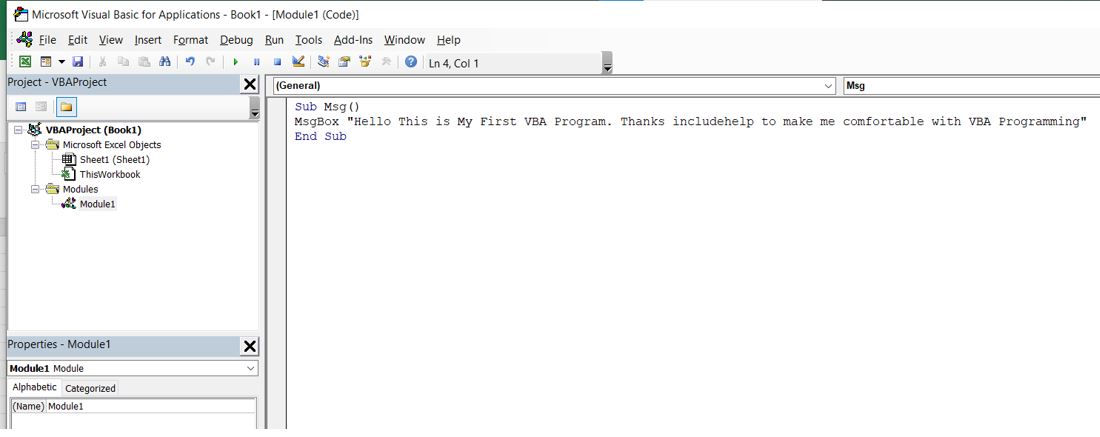
Click on Play Green Button to Run the Program:
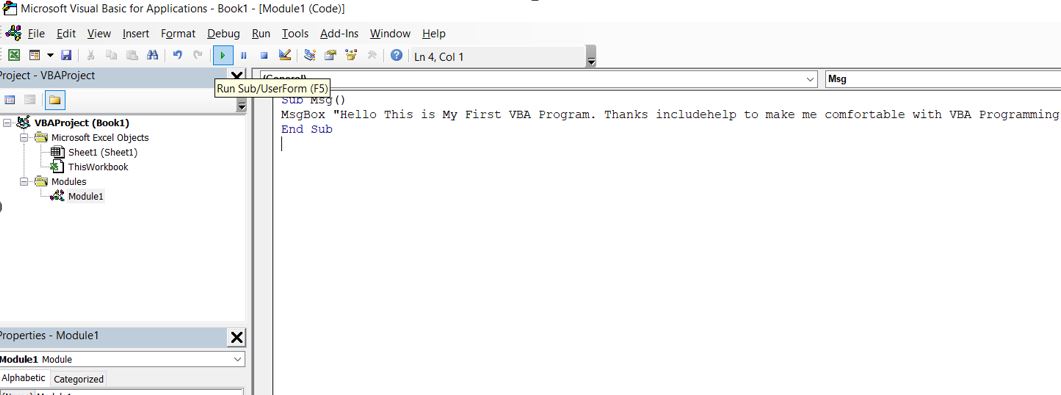
Output
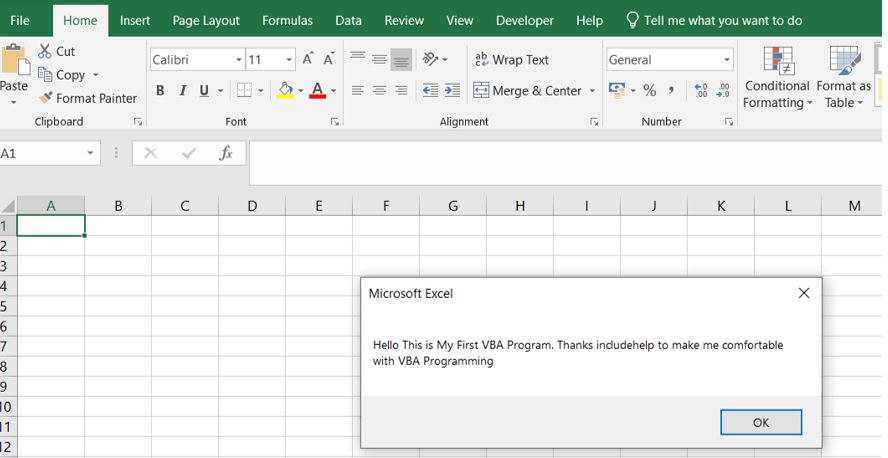
Key Characteristics of VBA
- Automation and Macros: Macros can communicate with program objects like cells in Excel or text formatting in Word. Users can automate repetitive tasks, such as formatting data, generating reports, or processing information.
- Integration with Microsoft Office Applications: VBA is specifically designed to integrate with Microsoft Office applications like Excel, Word, Access, and PowerPoint.
- Custom Solutions: VBA allows users to construct macros, user-defined functions, and interactive forms that are suited to their individual requirements.
- Event-Driven Programming: VBA enables event-driven programming, which allows users to write code that runs in response to specified events like opening a workbook, clicking a button, or changing a cell value.
- Extensibility: Beyond Office, VBA can interact with other external applications or databases, making it a versatile tool for broader automation. Hence, using APIs and libraries, VBA may communicate with databases, external files, and other programs.
Advantages of VBA
- Built into Microsoft Office, requiring no additional installation.
- Automation of Repetitive Tasks.
- User friendly even if users are non-programmers due to its simplicity.
- Provides the ability to create customized solutions.
- Ideal for small to medium-sized businesses.
- Reduces manual effort, enabling faster completion of projects.
- Automates data handling, including importing, cleaning, analyzing, and reporting.
- Very Useful for building complex models, such as financial models in Excel.
- Allows for Macro Recording - allows users to record tasks and convert them into code.
- Works effectively with large datasets in Excel or Access.
Disadvantages of VBA
- Restricted to windows systems and Microsoft apps.
- Slower than modern programming languages
- Not feasible for heavy computations.
List of VBA Programs
1. Write a VBA Program to Print a message
Code:
Sub msg()
MsgBox "This is my first VBA Program, Thanks https://www.includehelp.com/ to taught easily "
End Sub
Code Window:
Insert the code in the VBA editor under a module.
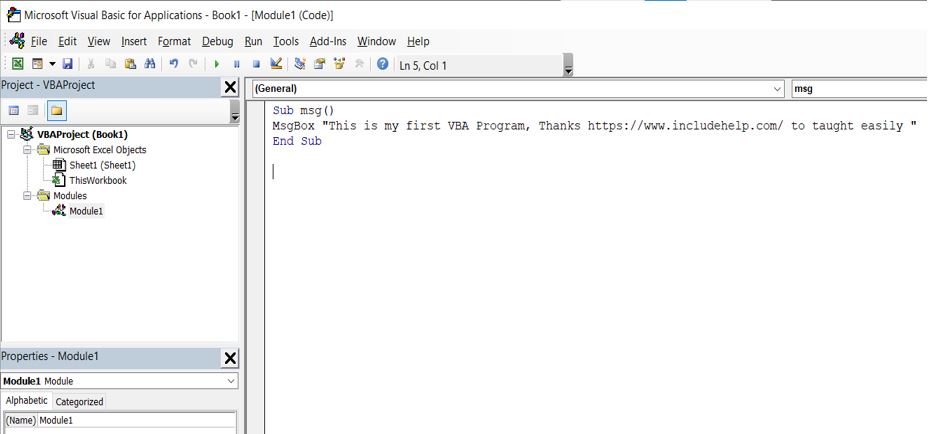
Output:
A message box will pop up displaying: "This is my first VBA Program, Thanks https://www.includehelp.com/ to taught easily".
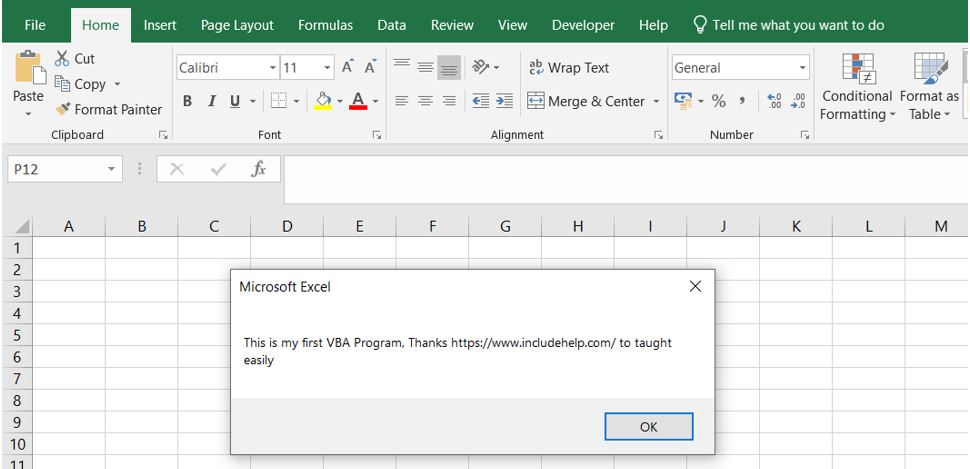
2. Write a VBA Program to Add Three Integer Numbers
Code:
Sub addition()
Dim num1, num2, num3, result As Integer
num1 = CInt(InputBox("input first number:"))
num2 = CInt(InputBox("input second number:"))
num3 = CInt(InputBox("input third number:"))
result = num1 + num2 + num3
MsgBox "Addition of inputted numbers is: " & result
End Sub
Code Window:
Insert the code in the VBA editor under a module.

Output:
A message box will display the sum of the inputted numbers.
3. Create a User Form in VBA, Input Three Numbers and Find Greater One
Code:
Private Sub CommandButton1_Click()
Dim n1, n2, n3 As Integer
n1 = CInt(TextBox1.Text)
n2 = CInt(TextBox2.Text)
n3 = CInt(TextBox3.Text)
If TextBox1.Text > TextBox2.Text And TextBox1.Text > TextBox3.Text Then
TextBox4.Text = TextBox1.Text
ElseIf TextBox2.Text > TextBox3.Text Then
TextBox4.Text = TextBox2.Text
Else
TextBox4.Text = TextBox3.Text
End If
End Sub
Code Window:
Insert the code in the VBA editor, and create a UserForm with TextBoxes and a CommandButton.
Output:
The largest of the three inputted numbers will be displayed in TextBox4.
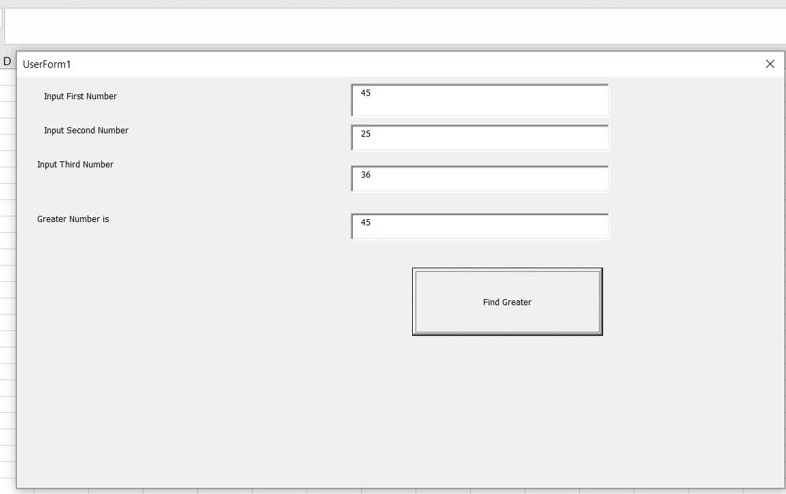
4. Create a User Form Using VBA to Check if a Number is Positive, Negative, or Zero
Code:
Private Sub CommandButton1_Click()
Dim n1 As Integer
n1 = CInt(TextBox1.Text)
If n1 > 0 Then
TextBox2.Text = "Positive"
ElseIf n1 < 0 Then
TextBox2.Text = "Negative"
Else
TextBox2.Text = "Zero"
End If
End Sub
Code Window:
Insert the code in the VBA editor, create a UserForm with TextBoxes and a CommandButton.
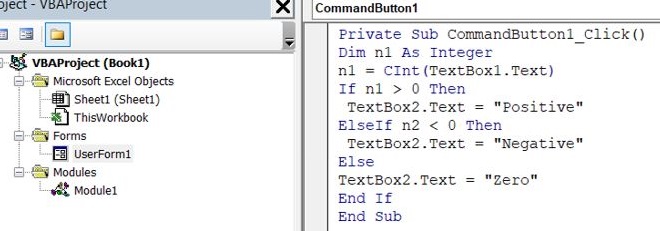
Output:
The appropriate message ("Positive", "Negative", or "Zero") will be displayed in TextBox2 based on the user input.
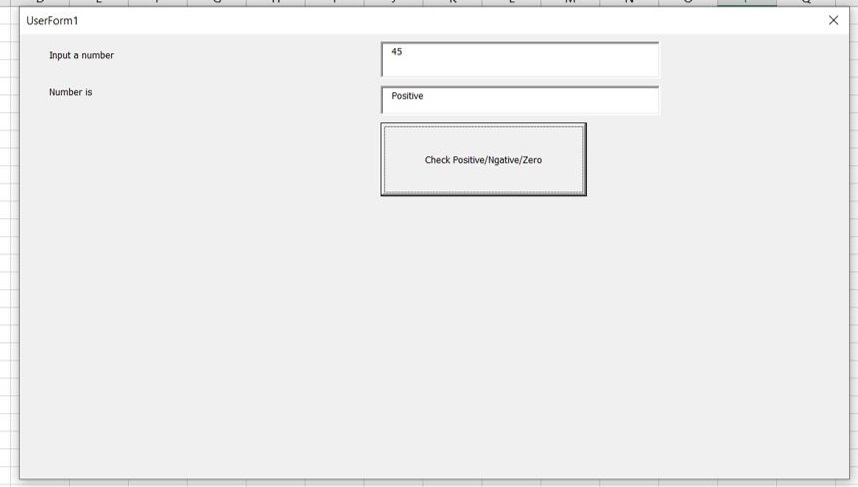
5. A VBA Program to Determine Discount Based on Purchase Amount
Code:
Sub discount()
Dim spentamnt As Double
Dim discper As Double
Dim amnt As String
amnt = InputBox("Please input spent amount:")
spentamnt = CDbl(amnt)
Select Case spentamnt
Case Is > 1000
discper = 10
Case 500 To 1000
discper = 5
Case Else
discper = 0
End Select
MsgBox "You are eligible for a " & discper & "% discount.", vbInformation, "Discount Percentage"
End Sub
Code Window:
Insert the code in the VBA editor under a module.

Output:
A message box will display the discount percentage based on the entered amount.

Advertisement
Advertisement